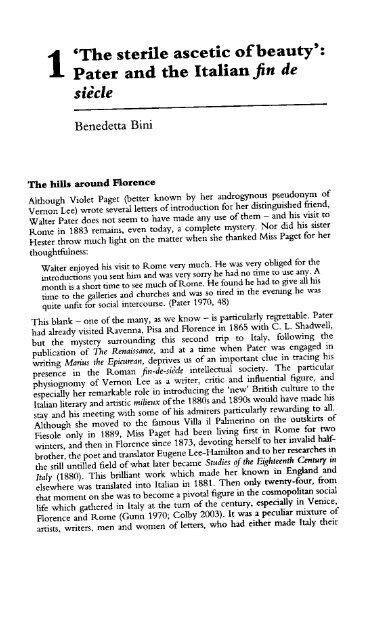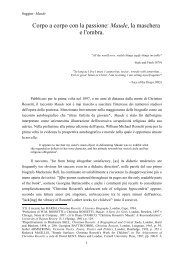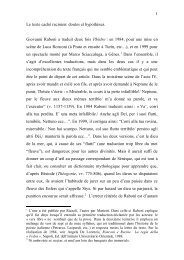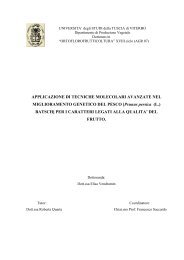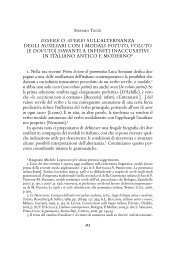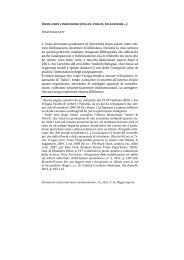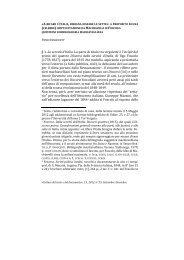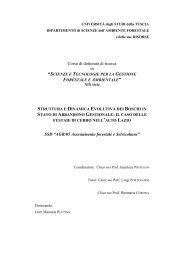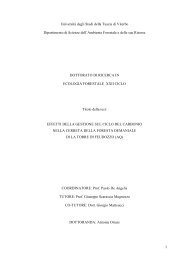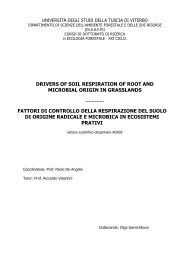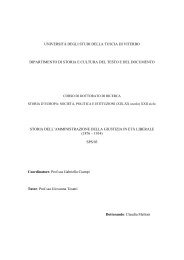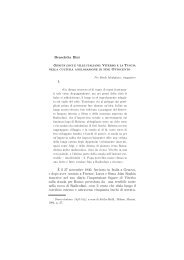I P"a"t and the Italian fin de - Unitus DSpace
I P"a"t and the Italian fin de - Unitus DSpace
I P"a"t and the Italian fin de - Unitus DSpace
Create successful ePaper yourself
Turn your PDF publications into a flip-book with our unique Google optimized e-Paper software.
.a 'The sterile ascetic ofbeautY':<br />
I P"a"t <strong>and</strong> <strong>the</strong> <strong>Italian</strong> <strong>fin</strong> <strong>de</strong><br />
síècle<br />
Bene<strong>de</strong>tta Bini<br />
Ttre hills around Florence<br />
Altbough Violer Paget (better known bv her rndrogynous pseudonym of<br />
Vemon Lee) wrote several ttttt" of int'oiuttion for hÉr disdnguished Éiend'<br />
to have ma<strong>de</strong> anv use of <strong>the</strong>m - <strong>and</strong>.his visit to<br />
ilil;;'P;;l ;;;;;,;;;-<br />
i#; t" ìi$ ie,,'ii,'s, tod"v, to-pittt mvstery Noldid his sister<br />
"'r.,' "<br />
il;; il;;..l úilt on <strong>the</strong> mjner when she thanked Miss Paget for her<br />
thoughtfulness:<br />
Walter enioved his visit to Rome very much He was very obliged for <strong>the</strong><br />
;;;;;;'.";;;;",,t-h;' *d *a"'J'v sorry he had no rime ro anv A<br />
'se<br />
;;;;"ì;;.;il. io<br />
'." -u'h of p'óme íle found he had to give all his<br />
'#:T""#';"iffi;-i ti",.rttt <strong>and</strong> was so tired in <strong>the</strong> evening he was<br />
q'"f" i"f. f3t social intercoune' (Pater 1970' 48)<br />
This blank - one of<strong>the</strong> many, as we know - is particularly,regre,nable Pater<br />
;jiJ*;<br />
ilo"ntt i; 1865 wirh C L Shadwell'<br />
"lri,.in""."..'pi'" "nd<br />
bur <strong>the</strong> myst€ry surroundlng this second trip to.Italy' following <strong>the</strong><br />
oublication of The Rendissance. <strong>and</strong> at a time when Pater was enpged .<br />
ilffiffiffi i"' ;ii;;;;;, À;pÀ"es us of an important clue in tracing his<br />
-".".nrp in <strong>the</strong> Roman nn-di-ti;at intellectui sociery' The- particular<br />
nTtH.il"';; v.-"i r"t' ut"'' critic <strong>and</strong> influentiaì fìgure' <strong>and</strong><br />
::l#ff;;" *-"*"ur. "t " role in introducrng <strong>the</strong> 'new' British rulture to <strong>the</strong><br />
;,fft' l,iJ; il;""ii. ,;i"" tr" t880"s <strong>and</strong> 18e0s would have ma<strong>de</strong> his<br />
"e<br />
"t-, .nrl hìs meetrns wirh ,"*. oi iii, adrnirers panicularly rewarding to all.<br />
ìÎtJ;il':il'.àou3a',f',i. i"-à"' villa ii Paimerino on <strong>the</strong> ourskirs of<br />
I'iii"t""ì"'i' iààó,'vi,, etg" had been living <strong>fin</strong>t.in Rome for two<br />
;H;,"*J ;;i""ii.;;' d;; iài'l' a'uo'i"gi.''errto her inverid halfùì"À.r.<br />
it. o.* -d ,,"ntltto' E"gtnt Lee-Hamil"ton <strong>and</strong> to.her researches in<br />
iiiii'l t'irí"àì[iJ .i *r'" l"te"became srudies oJ <strong>the</strong> Eight:nt! century in<br />
L,i. /tRRoì This brilliant *.* *iiln ma<strong>de</strong> hei known in Engl<strong>and</strong><br />
-<strong>and</strong><br />
:i:J*l'."':";,J il"'r","J'i"t' liii"" in 1881 Then onlv twentv-four' &om<br />
that moment on sh" *",,o ua.oi-.-. pi.,roul. figure in thé cosmopolitan social<br />
ì;;"'fi;h ;;;;i rn ltalv at tht tu* of tht1tnrury' especiallv in Venice'<br />
"ti:':;::';'ff'l; 1c"'í is?ó, óoiuv zoo:l' lt was a peculiar mixture or<br />
;;;;;;,;.n <strong>and</strong> womtn of lttttt'' *ho had ei<strong>the</strong>r ma<strong>de</strong> ltalv <strong>the</strong>ir<br />
in
20 The Reception of Waltu Pater in Europe<br />
permanent home, like Robert Browning <strong>and</strong> Elizabeth Barrett Browning,<br />
William Wetmore Story @ini 2004) <strong>and</strong> o<strong>the</strong>n, or had, like Henry f"-"r, tÈi<br />
habit of spending long periods of rime in ltaly.<br />
.- -I"^Fl"l.l9.<br />
<strong>the</strong> A-nglo-American community was particularly numerous<br />
(McComb 1966), <strong>and</strong> like any colony ofcultured e>.patriates inevitably prone<br />
to gossip, social rivalries <strong>and</strong> intellectual misun<strong>de</strong>nt<strong>and</strong>ings: notiúìg is<br />
probably_more significant than <strong>the</strong> long quarrel about aes<strong>the</strong>tics-ftrellek 1í70)<br />
which for many yea6 divi<strong>de</strong>d two troublesome neighboun, Bemarà<br />
Berenson <strong>and</strong> Vemon Lee, living at an uncomfortably short distance ftom<br />
each o<strong>the</strong>r on <strong>the</strong> hills around Fiesole (Samuels 1979). Then <strong>the</strong>re were her<br />
<strong>Italian</strong> fiends: <strong>the</strong> Baroness Elena French-Cini, <strong>the</strong> writer <strong>and</strong> émígd<br />
Giovanni Rufiìni, well known in Engl<strong>and</strong> for his novel Doaor Antonío (lgÈi)<br />
(Corrigan 1962), <strong>the</strong> critic Enrico Nencioni, <strong>the</strong> painter Telemaco Signorini,<br />
Pasquale .Villari <strong>and</strong> his English wife Linda, thè cosmopolitan .coiegiano<br />
mo<strong>de</strong>mo' (Praz 1944) Carlo Placci, friend of Berenson (pntazzi 1961)-, <strong>and</strong><br />
many o<strong>the</strong>n. For <strong>the</strong> 'expatriates', <strong>the</strong> occasional visiton fiom abroad, <strong>and</strong> her<br />
Florentine friends, <strong>the</strong> very opinionated <strong>and</strong> eccentric Vemon Lee was to<br />
become, probably more than any o<strong>the</strong>r figure of<strong>the</strong> time, a many-0Lceted trait<br />
d'union in <strong>the</strong> history of cross-cultural relations: introducing people <strong>and</strong> i<strong>de</strong>as,<br />
mjxing stereot,?es <strong>and</strong> discoveries, enchanting <strong>the</strong> mixe d-Florentine sociery<br />
with <strong>the</strong> unique gifts of her convenation. And, inevitably, making enemies.<br />
From <strong>the</strong> story ofher life, friends <strong>and</strong> relations, a fascinating portraìt cmerges<br />
of <strong>the</strong> - somehow inevitably distorted - mirroring of oie culture w.itÈin<br />
ano<strong>the</strong>r. At <strong>the</strong> same time, her acquaintance <strong>and</strong> friendship with some of <strong>the</strong><br />
Italirn líterctí nad,eher presence invaluable in <strong>the</strong> still provincial cultural life of<br />
<strong>the</strong> young <strong>Italian</strong> nation, in which <strong>the</strong> glorious season of English<br />
Romanticism was still consi<strong>de</strong>red <strong>the</strong> one <strong>and</strong> only acme of ,mo<strong>de</strong>m, artistic<br />
<strong>and</strong> critical achievement <strong>and</strong> which opened very dowly but wit}l eager<br />
innocence to a new un<strong>de</strong>nt<strong>and</strong>ing of English culture. If it is true that ihe<br />
circle which ga<strong>the</strong>red around her was <strong>the</strong> successor of<strong>the</strong> group which in <strong>the</strong><br />
1850s <strong>and</strong> 1860s had found its i<strong>de</strong>ntity around <strong>the</strong> Biownings <strong>and</strong> <strong>the</strong><br />
Trollopes (Pntazzi 1961), <strong>the</strong>n it is also true that <strong>the</strong> shift of trio or three<br />
post-Risorgimento <strong>de</strong>ca<strong>de</strong>s makes rhis Anglo-ltalian colony a very revealing<br />
<strong>and</strong> sigmficant paradigrn of <strong>the</strong> profound changes that <strong>Italian</strong> citure <strong>and</strong><br />
society were un<strong>de</strong>rgoing in those yean: reflecting, <strong>and</strong> reinterpreting, that<br />
great period of transformation involving <strong>the</strong> whole of Europe known as<br />
Deca<strong>de</strong>nce.<br />
It was into this circle of leamed anglopbìles <strong>and</strong> romantic italophìles that<br />
Vemon Lee was to introduce <strong>the</strong> new rrends of contemporary English<br />
literature <strong>and</strong> cuÌture (Zorn 2003): fìnt <strong>and</strong> foremost among oihers,'<strong>the</strong> name<br />
of WaÌter Pater would soon be circulating<br />
Vemon Lee had managed to meet Walter Pater in <strong>the</strong> summer of 1gg1 at<br />
Oxford.-Although in a letter to her mo<strong>the</strong>r she rememben him as a ,heary,<br />
shy, dull looking brown moustachioed creanlre over forty, much like<br />
Velasq 'e2'Philip IV, lymphatic, dull, humourless' (Lee 1937,7'8), <strong>the</strong>re is no<br />
doubt about <strong>the</strong> impression that his critical approach to <strong>the</strong> Renaissance <strong>and</strong><br />
<strong>the</strong>_ style ofhis imaginative prose had already left on her mind. As is known, a<br />
real friendship was soon to <strong>de</strong>velop betv/een <strong>the</strong>m, with pater obviously<br />
consi<strong>de</strong>ring Miss Paget a young <strong>and</strong> gifted scholar. Bekaro: Beínp Studies on
Pater <strong>and</strong> <strong>the</strong> Itdlían <strong>fin</strong> <strong>de</strong> siècle 27<br />
Sundry Au<strong>the</strong>tíal Qreslrorr (1881) seemed to prove that Vemon Lee had<br />
ab<strong>and</strong>oned forever <strong>the</strong> teaching ofRuskin in connection with which she had<br />
been gendy quoted by Robert Browning in'Asol<strong>and</strong>o' ("'No, <strong>the</strong> book /<br />
Which noticed how <strong>the</strong> wall growths wave", said she, / "Was not by<br />
Ruskin". ,/ I said, "Vemon Lee?"').<br />
As a matter offact, Vineta Colby's <strong>de</strong><strong>fin</strong>ition of Lee as a 'puritan aes<strong>the</strong>te'<br />
(1970), altemating between <strong>the</strong> two mo<strong>de</strong>s ofaes<strong>the</strong>tic reception, is very apt,<br />
<strong>and</strong> it will have its bearings on <strong>the</strong> early leception of Pater in <strong>the</strong> <strong>Italian</strong><br />
cultural world. In Lee's next collection of essays on <strong>the</strong> Renaissance,<br />
Euphoion (1884), she inclu<strong>de</strong>d a <strong>de</strong>dication to Pater ('in appreciation of that<br />
which, in expounding <strong>the</strong> beautiful things of <strong>the</strong> past, he has ad<strong>de</strong>d to <strong>the</strong><br />
beautiful things of <strong>the</strong> present') which <strong>de</strong>fìnitely put her among <strong>the</strong> true <strong>and</strong><br />
enthusiastic followen <strong>and</strong> emulaton of <strong>the</strong> master, as, later, would her<br />
remarkable writings on <strong>the</strong> genius lori (Bini 2003) <strong>and</strong> her shon stories, so<br />
obviously reminiscent of <strong>the</strong> in<strong>de</strong>lible trace left by her reading of lmaginary<br />
Pottruits.<br />
Vemon Lee's shift towards Pater is higtrly significant. This is not only<br />
because it follows a ten<strong>de</strong>ncy in criticism, typicù offn-<strong>de</strong>-sr'elle re<strong>de</strong><strong>fin</strong>ition of<br />
taste, which she shared with John Addington S1'rnonds, Swinbume, Oscar<br />
Wil<strong>de</strong>, Herbert Home <strong>and</strong> o<strong>the</strong>n. But it is also because she took on <strong>the</strong> role<br />
ofdisciple ofa new aes<strong>the</strong>tic credo in her actual writing on Pater, marking her<br />
position in <strong>the</strong> <strong>Italian</strong> cultural mílieu as <strong>the</strong> clever <strong>and</strong> up-to-date<br />
'correspon<strong>de</strong>nt' on English literary matten, at a time when <strong>the</strong> name of<br />
John Ruskin was still well known <strong>and</strong> respected among <strong>the</strong> ltalian reading<br />
public (Praz 1937). In fact, Vemon Lee had started as early as <strong>the</strong> mid-1870s to<br />
contribute to various ItaLian literary papets, la irista eurcpea, edited by Aagelo<br />
<strong>de</strong> Gubematis, had published her articles <strong>de</strong>aling with both <strong>Italian</strong> <strong>and</strong> English<br />
cultural issues: on <strong>the</strong> leading novelists of Engl<strong>and</strong>, but also on <strong>the</strong> need for<br />
<strong>the</strong> <strong>Italian</strong>s to have more respect for <strong>the</strong>ir own past greatness. She<br />
subsequendy went on to write for o<strong>the</strong>r joumals such as <strong>the</strong> farnous Fanfulla<br />
<strong>de</strong>lla domeniea (<strong>the</strong> cultural supplement to 11 fanfulla, edited by Ferdin<strong>and</strong>o<br />
Martini) which was soon to become one of <strong>the</strong> most relevant periodicals in<br />
tum-of-<strong>the</strong>-century ltaly.<br />
Although (or maybe because) Pater's presence in Lee's work is so pewasive<br />
as to act as a kind of general subtext, only a few direct comrnents on her<br />
mentor can be found in her writings. It was in <strong>the</strong> Fonfulla <strong>de</strong>lla domenía that,<br />
in 1885, she produced a lengthy article ('Ethics into Aes<strong>the</strong>tics: Notes on<br />
Walter Pater's New Book')' on Mdius <strong>the</strong> Epiureax in which she reveals her<br />
adrniration 'awakened by <strong>the</strong> sub<strong>de</strong>st of thinken <strong>and</strong> by <strong>the</strong> more artistic of<br />
writen in contemporary Engl<strong>and</strong>" <strong>and</strong> goes on to remember <strong>the</strong> succes of<br />
The Renaíssarce, <strong>the</strong> 'won<strong>de</strong>rful réveie on MonnaLisa', before introducing <strong>the</strong><br />
lesson of Manrr, seen as <strong>the</strong> figure of moralized aes<strong>the</strong>tics:<br />
Physical beauty, which is to say s)înmetry, purity <strong>and</strong> loveliness in <strong>the</strong><br />
material world, <strong>fin</strong>ds its equivalent in <strong>the</strong> strength, temperance <strong>and</strong> chasnry<br />
I 'La morale nell estence. appunti sul nuovo libro di Walter Prter.'<br />
' '<strong>de</strong>srata dal prù sordle pensàtore e dallo scrittore più artista <strong>de</strong>ll'am.rale Ingh.ilterra'<br />
(1).
22 The Reception of Walter patet ín Europe<br />
of<strong>the</strong> moral world. This th-ought is nor new. nay. rr is very encienr: rr was<br />
do!rula,ung,inruition of Greek an <strong>and</strong> poetry. a teachiíg rhrt w$ af(er<br />
,Èlìe<br />
au essennary ptaronlc, end that it was urrerly important tó recall rn our<br />
times, when <strong>the</strong> <strong>de</strong>sire for a sensation rvhi.h'rh;rid li'-ni* )ir-ilrriqr, ^,<br />
Pater himself had once <strong>de</strong><strong>fin</strong>ed ir, ma<strong>de</strong> rhe ,."r.f, f". lJ"Ju- rno.a<br />
<strong>de</strong>ath rnaìogous to <strong>the</strong> search for physrcal , --bea,rry<br />
""1<br />
Vemon Lee was later to mentjon Maius again, in <strong>the</strong> <strong>de</strong>dication of her<br />
collection of essals Juvenilía to her &iend Cì'rlo 'placci. H.i "ttitua" to tf,.<br />
novel seems ra<strong>the</strong>r romantic, lingerhg on <strong>the</strong> ,aes<strong>the</strong>tic, cl"ssic, Coethi"n<br />
dals' (1) evoked by <strong>the</strong> novel <strong>and</strong>.iÈ beirrg_.<strong>the</strong> Lehqire oi "r, "rruqo.<br />
Wilhelm Meister: but a Wilheln Meister simller, pur"., tor. alg;n.a ,h".,<br />
<strong>the</strong> hero of Goe<strong>the</strong>' (8). Given <strong>the</strong> status of Vemo; L"""od À.11i.lr"rr.. of<br />
<strong>the</strong> jouma.l where she wrote, it is legrtimate to assume tt "t tir. ì._.* of<br />
Maius must have left an impression on is rea<strong>de</strong>rs, especially those who were<br />
to become Miss?aget's good &iends <strong>and</strong> frequent visiion to'll palmenno. It is<br />
not a surprise. <strong>the</strong>n. that a joumal like Nror.,a antologia _ in which a section<br />
(-Norrzre dr Scienzf,. Letterarura ed Arte') was <strong>de</strong>voted to a briefupdating on<br />
<strong>the</strong> Europear_ literary world -<br />
should have informed its,."a.r" ùilssc ,rot<br />
onìy that Roben Browning was buying a house on <strong>the</strong> CaJ Gr<strong>and</strong>e in<br />
veruce but also that:<br />
Mesrs. MaîÍìrllàn & Co. publishen in London are abour to brinc fonh a<br />
new book by Mr. WJter Prrer. entirled Appre,iatíow.'<br />
Moreover:<br />
The May issue of Macmillan's Magazine conuins a piece by Mr. Freeman on<br />
I hc t)ucrcnrc betwcen Toúns <strong>and</strong> Boroughs <strong>and</strong> an èssay oÀ The Buthanals o!<br />
Euipí<strong>de</strong>s by Mr. Pater.'<br />
Concise though <strong>the</strong>y are, <strong>the</strong>se notes are illuminating in as much as <strong>the</strong>y tell us<br />
that Pater was n_o longer an unkrown name, but that"his fa-. t.JLu ìfr", Arn.<br />
Jready rerched ltaly's literary world. aìthough <strong>the</strong> frnt cranstation of Tle<br />
:r::-t-tt:!r" l"o M4rírr were only to_appear in l9l2 <strong>and</strong> 1939 respecrively. Not<br />
rruny peopte were able ro read in English: <strong>Italian</strong> sociery was still very'much<br />
French-oriented in its taste, <strong>and</strong> all ìhe new literary arlion, ,rrlu.a f.o_<br />
Paris. .Errglish po-etry had been wi<strong>de</strong>ly translated <strong>and</strong> would continue to be,<br />
<strong>and</strong> only a small group of cultured people were "Ut. to .""J-iot, in tt.<br />
'il bello<br />
_fisico,<br />
cioè<br />
_la<br />
simmetria, la,purezza e venustà nel mondo mareriaÌe,<br />
possie<strong>de</strong> il suo equivalente nella forza, li temperanza, la c"rri a _""a"-",i.A..<br />
Pensiero non nuovo, anzi antichissimo, intuizione dominante ".i j"U . a"U<br />
poesia greca; insegnamento in fondo essenzialmente platonico, """ l'-.À.<br />
importantissimo richiamarci ai nostri tempi, qu<strong>and</strong>o il <strong>de</strong>s'i<strong>de</strong>rio à.il" ..;;;r""" "r"<br />
nuoua eil unia, come I'aveva una volta difìnià lo stesso pater, h; i;;;-;;r.*"<br />
come anelogo <strong>de</strong>lle bellezza 6ric; la malaaia e la mone morale, t2)_ - - -'<br />
'Gli editoú Macmillan & Co. di Londra sun ro pubUti."oJo un'í,rouo lib.o <strong>de</strong>l<br />
rignor Walter Parer. intirolato Apprez zamcnti. (16 November).<br />
Il numero di maggio <strong>de</strong>l Matmillan,s<br />
.Magazine corrtierr. ,rno scrino <strong>de</strong>l Signor<br />
Freemen su Lt disrinzione ha tirtà p ónrotri e "uno studio s" t" iiir"iii ai f"iiA; a.l<br />
Srqnor Prcer' (1 May).<br />
I<br />
I
Pater awl <strong>the</strong> Italían <strong>fin</strong> <strong>de</strong> siècle 23<br />
original. Never<strong>the</strong>less, <strong>the</strong> slow process of <strong>de</strong>-provincialization of ltalian<br />
culture - of which <strong>the</strong> new approach to English liierature <strong>and</strong> criticism was a<br />
relevant factor - dates from this period. It reached is acme with d'Annunzio,<br />
coinciding also with <strong>the</strong> dow fading ofRuskin's supremacy in favour ofo<strong>the</strong>r,<br />
<strong>and</strong> more mo<strong>de</strong>m, sensibilities, a.lthough it was to receive its <strong>de</strong>cisive imperus<br />
more íìom <strong>the</strong> prestige of <strong>the</strong> new trends in European visual ans lpre-<br />
Raphaelites <strong>and</strong> Symbolism) than fiom <strong>the</strong> challenge of <strong>the</strong> written word.<br />
After Pater's <strong>de</strong>ath in 1894, Vemon Lee was to remember her master <strong>and</strong><br />
friend in <strong>the</strong> <strong>fin</strong>al chapter ofher Re"4i$ oflce Fdncíes afld Studres (1895). Here, as<br />
elsewhere, she pays homage to <strong>the</strong> name with which 'I began my hrst book<br />
on Renaissance matters', thus acknowledgrng <strong>the</strong> presence of pater as a<br />
constant gui<strong>de</strong> in her work, <strong>and</strong> <strong>the</strong>n goes on to draw a comparison between<br />
<strong>the</strong> author <strong>and</strong> <strong>the</strong> character of Marius:<br />
He began as an aes<strong>the</strong>te, <strong>and</strong> en<strong>de</strong>d as a moralist. By faithful <strong>and</strong> self:<br />
restraining cultivation of <strong>the</strong> sense of harmony, he appean to have risen<br />
from <strong>the</strong> perception of visible beauty to <strong>the</strong> knowled[e of beaury of <strong>the</strong><br />
spiritual kind, both being an expression of<strong>the</strong> seme perfect firtingnàss to an<br />
ever more intense <strong>and</strong> various <strong>and</strong> congruous life (255-56).<br />
These words, variously reinterpreted, would echo frequently in <strong>the</strong> next few<br />
yean in which <strong>the</strong> figure of Pater became little by little more visible in <strong>the</strong><br />
cosmopolitan culnre of <strong>the</strong> y6n-<strong>de</strong>-síelle society in ltaly.<br />
A good Aiend of Vemon Lee <strong>and</strong> a frequent yisitor at Il Palmerino was<br />
Enrico Nencioni, <strong>the</strong> <strong>fin</strong>t <strong>Italian</strong> man ofletters <strong>de</strong>stined to play an important<br />
role in <strong>the</strong> reception ofPater. Nencioni is a very intelesting transitionJ figure<br />
in <strong>the</strong> literary l<strong>and</strong>scape ofthat period, which is marked b1.a slow assimilation<br />
of more advanced cultural <strong>and</strong> intellectual trends &om abroad (Sormani 1975):<br />
his criticism, commen<strong>de</strong>d by Croce for his 'most precious grít [. . . ] sureness<br />
of taste', was later damned with faint praise as '<strong>the</strong> effusion of a fervent <strong>and</strong><br />
happy lover ofan' (Cicognani 1943, 371).l<strong>fin</strong> <strong>the</strong> 1890s he was not 'a critic<br />
in<strong>de</strong>ed nobody was yet, apart from <strong>de</strong><br />
in <strong>the</strong> rigorous sense of <strong>the</strong> word' -<br />
Sanctis - <strong>and</strong> if it is true that his approach to <strong>the</strong> arts was still in many respects<br />
impressionistic <strong>and</strong> honestly bourgeois praz 1943), his role in introd;cing<br />
English contemporary literature <strong>and</strong> thought to <strong>the</strong> <strong>Italian</strong> world cannot bé<br />
<strong>de</strong>nied or un<strong>de</strong>restimated.<br />
Enrico Nencioni was for twenty-three yean private tutor in a number of<br />
<strong>Italian</strong> aristocratic rnilieux, living ior -rny y""r, io Si.rr" with Count Gori<br />
Pannilini's family <strong>and</strong> meeting <strong>the</strong>re some interesting <strong>and</strong> famous figures of<br />
expatriates such as William Wetmore Story, Walter Savage L<strong>and</strong>or <strong>and</strong> <strong>the</strong><br />
two Brownings. It was only when Ferdin<strong>and</strong>o Martini asked hirn to join <strong>the</strong><br />
staft'of <strong>the</strong> Fanfulla <strong>de</strong>lla domenica that Nencioni moved to Rome, ùere he<br />
came in contact with some of <strong>the</strong> leading writers of <strong>the</strong> time like Luigi<br />
Capuana <strong>and</strong> Matil<strong>de</strong> Serao. From 1883 he lived in Florence, where he was<br />
appointed professor at <strong>the</strong> Istituto Superiore di Magistero (sccondary school<br />
for grrls), renewing his acquaintance with Vemon Lee. At <strong>the</strong> same time he<br />
began to <strong>de</strong><strong>fin</strong>e a more visible role for himself as a lecturer, a translator<br />
(Coleridge <strong>and</strong> Swinbume), a literary critic with a strong interest for French<br />
<strong>and</strong> Ìnglish contemporary literature, <strong>and</strong> a poet with a perceptive ea!. Among<br />
his manuscripts <strong>the</strong>re was found a long list of authon 'imit<strong>and</strong>i e traducendii
24 The Rueptíon of Walter Pater ín Eutope<br />
especially Hugo, Bourget, James, V. Lee, Hawthome, Ruskin <strong>and</strong> Pater<br />
1aìge[ iOle1. H. was later to write for some of <strong>the</strong> more influential'new'<br />
mag"zines of <strong>the</strong> time, <strong>the</strong> international joumal Nroza antologia, <strong>the</strong> Cronaca<br />
bizlttírc, directed by Angelo Sommarug, <strong>the</strong> Domenica letterdría <strong>and</strong> o<strong>the</strong>r<br />
periodicals, becoming a cìose &iend of several imPortant figures like Angelo<br />
Conti, Angrolo Orvieto (foun<strong>de</strong>r in 1896 of <strong>the</strong> magazine 11 Marzocco) <strong>and</strong><br />
Gabriele d;Annunzio. The latter had passionately <strong>de</strong>voured his essays while<br />
still at school at <strong>the</strong> Collegio Cicognani in Prato <strong>and</strong> was later to <strong>de</strong>dicate to<br />
him his Elegie romane, biú<strong>de</strong>s writing Fgvo articles in his memory when<br />
Nencioni di;d in 1896. The Saggí crítící di letteratuft írglese (Citícal Essays on<br />
Exglish Líteratwe), a collection of essays <strong>and</strong> reviews previously written for <strong>the</strong><br />
Niot a antologia, were published Posthumously in 1897 with- <strong>the</strong>,preface by<br />
Giosuè Carducci, <strong>the</strong> main poetical voice of post-unity Italy, Nobel prize<br />
winner for Poetry in 1907 <strong>and</strong> a lifelong friend- In <strong>the</strong>se essays Nencioni<br />
shows a liveiy curiosity <strong>and</strong> a frrm grasp ofEnglish <strong>the</strong>rnes <strong>and</strong> figures: as early<br />
as 1 867 he hid published an essay in th e Nuova antologia in which, introducing<br />
to <strong>the</strong> <strong>Italian</strong> rèa<strong>de</strong>r <strong>the</strong> poetry of Robert Browning, he had criticized <strong>the</strong><br />
<strong>Italian</strong> lack of curiosity with regard to English literature, especially rvhen<br />
compared to <strong>the</strong> craze rvhich surroun<strong>de</strong>d o<strong>the</strong>r influences from abroad:<br />
In Italv. where evervthing that comes from France, novel <strong>and</strong> poetry,<br />
criticism <strong>and</strong> hisrory, is riad voraciously, ùttle or norhing is known of<br />
mo<strong>de</strong>m <strong>and</strong> contemporary English LiteretLrre With <strong>the</strong> exception of B1'ron,<br />
'Walter Scott, Macaihy, th" oi-., of <strong>the</strong> great poets, novelists, critics <strong>and</strong><br />
historians who in oui century have flourished <strong>and</strong> are flourishing- in<br />
Enel<strong>and</strong> are. generally speakrng, new names in ltaly, while perhaps of all<br />
fo.íign lit.raù..t thé one that- can be studied with <strong>the</strong> greatest profit by<br />
Italiars is <strong>the</strong> English "<br />
The essay is illuminating in that it states very clear\ what was to be for many<br />
generatións <strong>the</strong> trend : <strong>and</strong>, if you like, <strong>the</strong> paradox - of-<strong>Italian</strong> cultural<br />
iociety: firll of anglophiles, but at <strong>the</strong> same time strang€ly reluctant to<br />
approich English.oltot" on a very superficial level, <strong>and</strong> apparently<br />
itràift-"."trt to itr fot-al <strong>and</strong> "*."pt critical <strong>de</strong>veloPments. This exPlains also <strong>the</strong> scanty<br />
direct comments we <strong>fin</strong>d in those yean relating to Pater <strong>and</strong> his work, even in<br />
such a favourable milieu as <strong>the</strong> one that Vemon Lee had created around<br />
henelf, where <strong>the</strong> magic of Pater did not go unnoticed.<br />
There were, ofcoune, a few notable excePtions, like Nencioni himsell ln<br />
his reviews <strong>and</strong> essays for <strong>the</strong> various periodicals of <strong>the</strong> time he showed<br />
remarkable insight <strong>and</strong> passion in introducing new English <strong>and</strong> American<br />
literary voices to <strong>the</strong> Italiin public: Rossetti, Whitman, Tennyson,- Swinbume<br />
<strong>and</strong>, later on, even HenryJames, at a time when <strong>the</strong> American author was still<br />
6 'In ltrli", dove si legge avidamente ogri scrino che viene di Francia, romanzo e<br />
ooesia. critica e stoli". Doco o nulla si sa <strong>de</strong>lla letteratura inglese mo<strong>de</strong>ma e<br />
iorr,"-poon"r. Se ne eccettui Byron, Walter Scott, Macaulay, i nomi <strong>de</strong>i gr<strong>and</strong>i<br />
poeti, d;i gî<strong>and</strong>i romanzieri, <strong>de</strong>i critici e <strong>de</strong>gli storici che nel secol nostro han<br />
ho.ito. fióri..otto in Inghilterre sono, generalrnente parl<strong>and</strong>o, nomi nuovi in<br />
Italia: mentre forse di tuttè le straniere letterature quella che con maggior pro<strong>fin</strong>o<br />
potrebbe studiani clagl'ltaliani è la inglese' (1)
Pater <strong>and</strong> <strong>the</strong> ltalian <strong>fin</strong> <strong>de</strong> siècle 25<br />
relatively unknom on <strong>the</strong> Continent. His ftendship with Vemon Lee, who<br />
always- consì<strong>de</strong>red him a very good friend<br />
".rd -Éo d.di."t.Jio ni_ ,fr.<br />
:.:olq :d,h9: of her Srr/ies oJ rhe Eighteenth Century ín ltaly (1907). was<br />
helpful in wi<strong>de</strong>ning his circle of English expatriates <strong>and</strong> provijing him with<br />
new means to.investigate <strong>the</strong> contemporary English worîd of len"en. In two<br />
reviews oflee's works (Euphoion <strong>and</strong> Juveiilial ln rhe Nuova antolopia patet is<br />
mentioned on <strong>the</strong> one h<strong>and</strong> as havingìnfluenced <strong>the</strong> style of Miss Faget with<br />
his 'meditative calm <strong>and</strong> lucid cJntrol',' arrd o., ihe oifr., *" fr""i"g<br />
contributed, toge<strong>the</strong>r with Ruskin, Synonds <strong>and</strong> Lee herself, to <strong>the</strong> aàrnirable<br />
19w lren{ glEngtish studies on Botticelli. Only in 1890 did Nencioni <strong>de</strong>al<br />
direcdy with Pater, <strong>and</strong> this was in his rcview of Apprecíatirru, orrce "gain Éom<br />
<strong>the</strong> pages. ofNaoua anrología. After acknowledging iúe value ol <strong>the</strong> iTnaissante,<br />
Nencioni characterizes Pater's role as a critic:<br />
For him a painting. a characrer, a pLnt. a poem. have a special value <strong>and</strong><br />
<strong>de</strong>serve to. be anÀlysed onJy for <strong>the</strong>ir faculry to procure ús a distinct <strong>and</strong><br />
untorgenible impression of pleasure. He is in thè world of criticism what<br />
Lrànte cabnel Rossetti was in rhe world of poetry: a re<strong>fin</strong>ed. aristocraric,<br />
a:rd if <strong>the</strong> word did not often have an odioui meíning, I *ootJ A,o ,"y<br />
frne <strong>and</strong> <strong>de</strong>lrctte dílettante.s<br />
"<br />
Characteristically, Nencioni sees what he calls .dilettantismo. <strong>and</strong> .pessimismo,<br />
as <strong>the</strong> two main currents ofcontemporary Lterature. p"t.. i, oo"'oiih" -ort<br />
exquisite representatives of<strong>the</strong> fiIst category, argues Nencioni, addine that <strong>the</strong><br />
author shares with dl <strong>the</strong> o<strong>the</strong>r aes<strong>the</strong>ùc i.itlcl ttre ui.. "f.*pr.rri'lrg id."r,<br />
which are sometimes far from being original, in "n or".,l1", 'torr.. É"lrirrg<br />
stated <strong>the</strong>fimits ofPater's work, Neniioniixpresses his appreciation for all <strong>the</strong><br />
essays in <strong>the</strong> volume, among<strong>the</strong> most beautiful <strong>and</strong> perfecì of mo<strong>de</strong>m English<br />
prose, <strong>and</strong> goes on to remark that<br />
The. greatest of mo<strong>de</strong>rn <strong>and</strong> contemporary cridcs rn Europe are in <strong>the</strong>ir<br />
writings - even in <strong>the</strong>ir most scholar[y <strong>and</strong> phìIosophical pjees _;sts of<br />
t..y"t able ro produce re wotb, oJ ai: such *" wìff.?ìL iif,t"gA.<br />
Carlyle, Ruskin. Micheler. Sainte-Beuvé, Taine, Renan.<br />
How is it that in ou-r<br />
_country, apart from a very few <strong>and</strong> commendable<br />
literary. artisrìc or historical criticism is vulgady<br />
:_]j:-!:"3. i b:gk :{<br />
I^1Y,,[ :] wìthout life,.or'warmth, or.colorr, -i h."; g*;.1;;y";;<br />
boring like a slate roof in November? I think thai tÉ...*"ilì"., f*,ii"<br />
"ì<br />
part, in this. The<br />
-being<br />
ltalian tralian critic criric has <strong>the</strong> rhe dred dread nfheinc of being t"L.- taken s^. f"; "'-^,", ; ;;"; _;.';; l-^.-<br />
a6aidof being accused accused ofnot of not being su6ìciendy su6ì.i.n,ly s";""u, r";o-urlr,à ,"a ,.l"rtín.. fii. i.<br />
absurd. Ary real criricism is i or :hould be - , a resulTectlon. an<br />
interpretation of Jife.e<br />
'calma riffessiva e lucido ordrne'(81).<br />
'Per lui un quadro. un personaggio, una pianu. una poesie, hanno specialc valore e<br />
menrano essere tnetrzzetr solo in quanto hanno facolti di procurarci una distinta e<br />
rndlmenncab c impressione di piacere. E' nel campo <strong>de</strong>lla critic quel che fu<br />
Dante.Gabriele Rosserd nel carnpo poetico: un rahnato, ,rn ".i.to'cotil
26 The Reeption of Waher Pater in Europe<br />
Nencioni's lucid awareness of <strong>the</strong> necessity for a different critical approach is<br />
what really drives him to write this review: although not completeiv without<br />
flaws, Pater's image slowly emerges as <strong>the</strong> mo<strong>de</strong>ì oia new sryli of criticism. It<br />
was in this role that his fame was ro assef itself in <strong>the</strong> i890s <strong>and</strong> especially in<br />
<strong>the</strong> Roman.,6n-<strong>de</strong>-sie'cle artistic circles. For <strong>the</strong> moment, holvever, ipart from<br />
<strong>the</strong> insights of Nencioni, he remains <strong>the</strong> fascinating but slightly dr.,g.row<br />
essayist whose influence, although elusive, is in <strong>the</strong> process oi emerging from<br />
behind <strong>the</strong> scenes to capture <strong>the</strong> attention ofVemon Lee, placci <strong>and</strong> ó<strong>the</strong>n.<br />
Un<strong>de</strong>nt<strong>and</strong>ably, more attention is given to Pater's gifts as a new interpreter of<br />
<strong>the</strong> Renaissance than as a naÍator: <strong>the</strong> more subvenive aspect of Manlrs <strong>and</strong> of<br />
<strong>the</strong> Imagínary Poiralts seems to have been overlooked - or, in <strong>the</strong> case ofl-ee.<br />
just v€ry <strong>de</strong>ftly interwoven into her own writing. Soon Pater would become a<br />
name in a selected group ofauthon who would be cited as participating in <strong>the</strong><br />
new trend of <strong>the</strong> aes<strong>the</strong>tic essay: even, perhaps, slightly neutralized in <strong>the</strong><br />
proce-ss <strong>and</strong> reduced to an icon of <strong>the</strong> cultivated traveller. Nothing is more<br />
revealing of this new habit than a review of Vemon Lee's Euphoiin by <strong>the</strong><br />
cosmopolitan Carlo Placci (Cambieri Tosi 1984) for <strong>the</strong> Fonfulí; <strong>de</strong>lla domeníca<br />
in 1884:<br />
Who has enjoyed_ more fully a reading of texts from <strong>the</strong> Elizabethan agc<br />
than those who have had as companions Symonds to or<strong>de</strong>r <strong>the</strong>m aÀd<br />
Swinburne to reproduce rhe impressions <strong>the</strong>reolì What lesson of<br />
archirecture has been more fascinatilg rhan <strong>the</strong> one you have received<br />
w<strong>and</strong>ering along <strong>the</strong> Canal Gr<strong>and</strong>e with a book by Ruskin on your knees?<br />
Wlnt gui<strong>de</strong> mole attractive than a chaprer of Parer to help us'un<strong>de</strong>nr<strong>and</strong><br />
with pleasure a dance by Botticelli?"'<br />
Had he written this review a few years later, Placci would have ad<strong>de</strong>d to this<br />
list ofnames that of<strong>the</strong> eccentric architect <strong>and</strong> connoisseur Herbert p. Home,<br />
editor of <strong>the</strong> Century Guíld Hobby Horse, a frequent visitor to Italy <strong>and</strong> from<br />
1904 a permanent resi<strong>de</strong>nr in Florence (Fletcher 1970). A collector of<br />
primitives, Renaissance fumiture, Old Masters' drawings, Home was to buy<br />
Palazzo Corsi in Via dé Benci <strong>and</strong> bequeath it <strong>and</strong> his collection to thé<br />
Foundation which still bean his name. tJ.is Bottícellí: Paínter of Florence (190g),<br />
profoundly influenced by his friend Wa.lter Pater, would 'be <strong>the</strong> <strong>fin</strong>al <strong>and</strong><br />
opere il'afte: tali Guglielmo Schlegel, Carlyle, Ruskin, Michelet, Sainte-Beuve.<br />
Taine, Renan.<br />
Come va che da noi, fatte pochissime e più lo<strong>de</strong>voli eccezioni, un libro di critica<br />
lettearia, artistica, o storica, è quasi sempre scitto barbaramente [...] senzr vira,<br />
senza calore, senza colorito, senza allettamento veruno, grigio ed uggioio come un<br />
tetto di lavagna in novembre? [o credo che <strong>de</strong>rivi, almèno in patl da questo. Il<br />
critico italiano ha una sacrosanta paura di passar da poera - e che gli si ad-<strong>de</strong>biti di<br />
non esser abbastanza serio e scientifico. Ed è ul assurdo. Ogni vea critica è, o<br />
, dovrebbe es\ere. una resurîezrone. una interpretazrone di vita: (417-18).<br />
t" 'Chi ha gioito piu pienamenre d'une lettu'ra di testi <strong>de</strong>ll,epoca e[sjettiana di<br />
quelli. che h-anno avuto a compagni il Symonds per ordinarli, e il Swinburne per<br />
riprodume le impressioni? Quale lezione d'architettura è stata più affascinant; di<br />
quella che avete ricevuto vag<strong>and</strong>o pel Canal Gr<strong>and</strong>e con il libio di Ruskin sulle<br />
ginocchia? Quale guida più amaente di un capitolo <strong>de</strong>l pater, per aiurarci a<br />
contemplare con più piacere una danza <strong>de</strong>l Botticelli?, (10).
Pater <strong>and</strong> <strong>the</strong> ltalian <strong>fin</strong> <strong>de</strong> siècle 27<br />
<strong>de</strong>fir]itive<br />
.cntical<br />
statement that put Botticelli back into <strong>the</strong> canon (Kermo<strong>de</strong><br />
1985). Indirecdy, it served <strong>the</strong> same function for pater himself<br />
. This new cult of<strong>the</strong> painter of 'The Birth ofVenus'was soon to become,<br />
slgnffic<strong>and</strong>y, <strong>the</strong> <strong>the</strong>me of a novel, although a minor one. ln bts Un furto (A<br />
Thef,1890), Carlo Placci tells <strong>the</strong> story ofan amateur an historian whó steali a<br />
painting, convinced it can be attributed to Botticelli. The hero is <strong>de</strong>scribed as<br />
reading<br />
with admiration <strong>the</strong> <strong>fin</strong>e sentences ofvemon Lee, pater <strong>and</strong> o<strong>the</strong>r English<br />
writen [ ., . ] <strong>the</strong>se critics possessed extraordlnary gifts o<strong>fin</strong>tuirion <strong>and</strong> a"real<br />
love for <strong>the</strong> Quattrocentisú; moreover, <strong>the</strong>y sórietimes were able to 6nd<br />
<strong>the</strong>. right epi<strong>the</strong>ts, to <strong>de</strong><strong>fin</strong>e <strong>the</strong> temperamént, <strong>and</strong> paint <strong>the</strong> sryle of <strong>the</strong><br />
various artists of that age.t'<br />
Ano<strong>the</strong>r kind of literary presence, however, was nee<strong>de</strong>d to embody more<br />
fiily <strong>the</strong>se aspects ofPater's work: <strong>and</strong> this could only be <strong>the</strong> controveniaì <strong>and</strong><br />
highty gifted figure ofd'Annunzio. It was only when his star began to rise in<br />
<strong>the</strong> firmament offn-<strong>de</strong>-siècle ltallan literature that <strong>the</strong> figure ofpaier seemed to<br />
emerge more clearly, even though - perhaps inevitably - reduced to a usefirl<br />
stereot'?e of <strong>the</strong> <strong>de</strong>ca<strong>de</strong>nt.<br />
in this context is Nencioni's review _ ^V^eryrevealing<br />
in th e Nuova antología in<br />
1889 (Two New Novels'r,), of d'Annunzio's Il piacere (The Child of plùsure)<br />
<strong>and</strong> Matil<strong>de</strong> Serao's All'ena sentínella! (looh out, sintry!). Here, <strong>and</strong> for <strong>the</strong> very<br />
first time, Pater is seen not only as an author but as tie majorinfluence on thè<br />
characterization of d'Annunzio's <strong>fin</strong>t hero:<br />
hav_e<br />
\{any been quoted as being <strong>the</strong> mo<strong>de</strong>ls for d'Arrrunzio: Gauner,<br />
Flaubert, Goncourt, Mendès, <strong>the</strong> Quattrotcntisti, <strong>the</strong> pre-Raphaelites, Kear,<br />
Shelley, Rossetti, Alma Ta<strong>de</strong>ma, Micherci [ . . . I <strong>and</strong> nobodv has mentioned<br />
Pater [ . . . ] Il píacere has more affìru<strong>de</strong>s wirh his Manrls rie Epícurean than<br />
with any o<strong>the</strong>r novel. poem or painring. But whar does that pràve? perhaps<br />
d'Annunzro does not even know Parer-s novel; <strong>and</strong> rhe af<strong>fin</strong>iry <strong>de</strong>nves ojy<br />
6om <strong>the</strong> kindred similarity of <strong>the</strong> two temperaments.,r<br />
The statement, although almost hid<strong>de</strong>n in a minor review of <strong>the</strong> time, scems<br />
relevant for two reasons. Fint, it reveals in Nencioni <strong>the</strong> abilìty to <strong>de</strong>tect <strong>the</strong><br />
presence of a dialogue between rwo texts that stem &om different cultures.<br />
Secondly, it forms a significant transition between two ways of interpreting<br />
l2<br />
13<br />
'<strong>de</strong>lle belle Gasi di Vemon Lee, di Pater e di altri inglesi [...] questi cntici<br />
posse<strong>de</strong>vano un'intuizione sfaordineria, ,.t.t ve.o "-oÈ pei i Quimocenusri;<br />
inoltre, sapevano qualche volta trovare giusti epiteti per caratterizzare I'indole, e<br />
dipingere la maniera <strong>de</strong>i diveni arristi di quel tempoi (118;.<br />
'Due nuovi romanzi'.<br />
'Si sono citati rnolti nolelli <strong>de</strong>l D'Arnunzio: e Gaucier, e Flaubert, e Goncoun, e<br />
Mendès, e i quamocenristi, e i Prerafaelliti, e Kear, e Shelley, e il Rosetti, e<br />
Alma Ta<strong>de</strong>ma, e il Michetri [. . . ] e nessuno ha ricordato il pater, col cuj Marius<br />
<strong>the</strong> Epiurcan Il píarere ha più afIìnità che con qualsiasi altro rorrunzo, poema o<br />
pittura. Ma ciò che prova? Forse il D'Annunzio non conosce neppure il-libro <strong>de</strong>l<br />
Pater; e la somiglianza <strong>de</strong>riva solo dall'indole corxinile <strong>de</strong>i due-ingegni' (664).
28 The Reception of Walter Pater in Ewope<br />
Pater, shifting i<strong>de</strong>ally to d'Annunzio <strong>and</strong> <strong>the</strong> cultural climate of <strong>the</strong> Roman.;6r<br />
<strong>de</strong> síeile.<br />
IfFlorence had been <strong>the</strong> filst literary scenario for <strong>the</strong> introduction ofPater's<br />
work into Italy, Rome would prove to be <strong>the</strong> perfect visual setting for its -<br />
however elusive - canonization.<br />
The lure of Rome<br />
Had d'Annunzio read Mdius by <strong>the</strong> time that he composed 11 piarcre? He<br />
might have done. We know that some of Pater's works were present in his<br />
library. They are heavily un<strong>de</strong>rlined, although it is difiìcult to establish <strong>the</strong><br />
date ofhis actual reading. The eclectic <strong>and</strong> ambitious young poet from Pescara<br />
was a voracious rea<strong>de</strong>r, <strong>and</strong> at that stage of his apprenticeship was particularly<br />
fascinated by <strong>the</strong> English 'movimento estetico': Swinbume, Wil<strong>de</strong> <strong>and</strong> Pater<br />
ale <strong>the</strong> names always mentioned as being fundamental in his approach to - <strong>and</strong><br />
discovery of - mo<strong>de</strong>mity (Anceschi 1976). Cultural life in post-unity Rome<br />
was erperiencing a moment of great <strong>and</strong> creative excitement <strong>and</strong> it was<br />
especially <strong>the</strong> fate of <strong>the</strong> yisual ars to fall un<strong>de</strong>r <strong>the</strong> spell of European<br />
Symbolism <strong>and</strong> take <strong>the</strong> lead in <strong>the</strong> battle against what seened <strong>the</strong> old <strong>and</strong><br />
dusty supremacy of Realism, <strong>the</strong> vulgariry of Verismo, <strong>the</strong> uninspiring legacy<br />
of positivism @amigella 1981).<br />
New magazines hke 11 Convito <strong>and</strong> Cronoca bizaxtina were emphatically<br />
advocating a different approach to art <strong>and</strong> criticism, ga<strong>the</strong>ring un<strong>de</strong>r <strong>the</strong>ir<br />
bannen <strong>the</strong> best t<strong>de</strong>nts of tlat generation: painten, sculpton, writers, critics,<br />
who all looked at <strong>the</strong> great artistic movements in Europe <strong>and</strong> especially at <strong>the</strong><br />
English experience as <strong>the</strong> fertil€ example to imitate (Fr<strong>and</strong>ini 1972). The first<br />
Esposizione Intemazionale di Belle Arti which took place in Rome in 1883,<br />
<strong>and</strong> <strong>the</strong> turmoil which followed, were probably a watenhed in <strong>the</strong> <strong>de</strong><strong>fin</strong>itive<br />
rejection of aca<strong>de</strong>mic taste. Three yean later, <strong>the</strong> grolp Ix A* Libertas,<br />
foun<strong>de</strong>d in 1886 by <strong>the</strong> painter Nino Costa in <strong>the</strong> premises of an historical<br />
meeting-place for artists, <strong>the</strong> Caftè Greco in Via Condotti (Angeli 1930), had<br />
been conceived as an imitation of <strong>the</strong> Pre-Raphaelite bro<strong>the</strong>rhood. The<br />
are <strong>the</strong> same<br />
names of its mernben - Cellini, Coleman, Sartorio <strong>and</strong> o<strong>the</strong>n -<br />
that would be found ga<strong>the</strong>ring round Il Convíto, one of <strong>the</strong> most<br />
representative magazines of <strong>the</strong> literary <strong>and</strong> anistic tastes of Roman;6n <strong>de</strong><br />
si,eUe. Nino Costa had a.lways had close contacts with <strong>the</strong> English amstic<br />
milieu: his lifelong friendship with Fre<strong>de</strong>ric Leighton dated from 1849, <strong>and</strong> he<br />
himself had exhibited at <strong>the</strong> Grosvenor Gallery in 1862. lt was probably<br />
through him that <strong>the</strong> fìrst real knowledge of<strong>the</strong> Pre-Raphaelites' work had<br />
reached <strong>the</strong> artistic circles in Rome, whereas it was through Angelo Conti's<br />
reading of Ruskin that <strong>the</strong> attraction to <strong>the</strong> Bro<strong>the</strong>rhood <strong>and</strong> <strong>the</strong> revaluation<br />
of Botticelli found its intellectual justification (Piantoni 1972; d'Arna 199ó).<br />
O<strong>the</strong>r painten like Cabianca, Carl<strong>and</strong>i <strong>and</strong> <strong>de</strong> Maria had worked in London<br />
in <strong>the</strong> 1880s, bringing back new i<strong>de</strong>as <strong>and</strong> suggestions which <strong>the</strong>y were to use<br />
as a weapon in <strong>the</strong> same bat<strong>de</strong> against Naturalism, <strong>the</strong> medievalism of <strong>the</strong> Pre-<br />
Raphaelites <strong>and</strong> <strong>the</strong> classical inspiration of Alma Ta<strong>de</strong>ma <strong>and</strong> Fre<strong>de</strong>ric<br />
Leighton. These nvo painters, it is wonh remembering, had lived <strong>and</strong> worked<br />
in Italy. The fact that <strong>the</strong> <strong>de</strong>bate around <strong>the</strong> figurative arts was so central to <strong>the</strong>
Pater <strong>and</strong> <strong>the</strong> Italían <strong>fin</strong> <strong>de</strong> siècle 29<br />
Rome of <strong>the</strong> 1880s-90s paved <strong>the</strong> way for <strong>the</strong> emergence of Walter pater as<br />
<strong>the</strong> hid<strong>de</strong>n maestrc of a new <strong>the</strong>ory of art <strong>and</strong> ofa new way of interpreting<br />
history - <strong>and</strong> memory-<br />
It was through th€ vogue of <strong>the</strong> Pre-Raphaelites, to whom he had been<br />
introduced by Nencioni, that d'Annunzio had <strong>fin</strong>t discovered that English<br />
aes<strong>the</strong>tic world which was to be so influential on <strong>the</strong> anglophilia oi his<br />
Roman yean (Sborgi 1990), shared with <strong>the</strong> enriîe artistic ind intellectual<br />
rnilieu with which he had come in contact. Berween 1890 <strong>and</strong> 1g92 <strong>the</strong><br />
annual exhibitions of <strong>the</strong> In Arte Líbeaas goup had showed for <strong>the</strong> <strong>fin</strong>t time<br />
works by D. G. Rossetti <strong>and</strong> Bume-Jones (who in tlle same years was drawing<br />
<strong>the</strong> mosaics for <strong>the</strong> Protestant Church of S. Paolo <strong>de</strong>ntro leMura in Romef<br />
Although it was only in 1893 that <strong>the</strong> Biennale di Venezia presented a more<br />
complete survey of<strong>the</strong> Pre-Raphaelites, <strong>the</strong>ir style was a corrtinuous source of<br />
imitation <strong>and</strong> questioning; <strong>and</strong> various contributions to Il Convito (1895) by<br />
<strong>the</strong> charismatic painter Giulio Aristi<strong>de</strong> Sartorio on Dante Gabriel Rosseni anà<br />
parnting<br />
fnglish<br />
would represent an importalt milestone. Sartorio especially<br />
highlighted <strong>the</strong> last phase of <strong>the</strong> movement, with its more explicit Symbolùi<br />
tum, <strong>and</strong> associated it with Pater as well as Swinbume, Bume-Jones <strong>and</strong><br />
Morris.<br />
Rome, <strong>the</strong>n, was signific<strong>and</strong>y receptive towards English culture <strong>and</strong> an at<br />
this moment. Gabriele d'Annunzio was quick to c"pture <strong>the</strong> spirit of <strong>the</strong><br />
times, <strong>and</strong> transform what for o<strong>the</strong>rs was a simple source of i<strong>de</strong>ological<br />
irupjration into something more complex. Pater, as we shall see, is <strong>the</strong> filrrre<br />
in <strong>the</strong> carpet-in his <strong>fin</strong>t phase, coinciding with <strong>the</strong> publication of 11 placere<br />
('Ihe Child of Pleasure, 1889), Lz uergíní <strong>de</strong>lle Rocce (The Maí<strong>de</strong>n oJ <strong>the</strong> Roctes,<br />
7896), 11 fuoco<br />
(The Flame, 1900) <strong>and</strong> some essays in <strong>the</strong> pages of Cronaa<br />
bízantína, I1 Convíto <strong>and</strong> Il Marzocto (Oliva 1979). AÌthoughlhe extent of<br />
d'Annunziol celebrated anglophilia, <strong>and</strong> its consequences, éxceed <strong>the</strong> scope<br />
of this chapter, this is <strong>the</strong> broad <strong>and</strong> colourful scenario - ma<strong>de</strong> of imiutions,<br />
contaminations, forgeries <strong>and</strong> social rituals - in which we have to saarr our<br />
quest for <strong>the</strong> traces ofPater in lta,ltan j.n-<strong>de</strong>-siècle art <strong>and</strong> aes<strong>the</strong>tics. The quest<br />
i-s n9t e9ry - or maybe it is all too easy. The continual reference to English<br />
Aes<strong>the</strong>ticism, Symbolism <strong>and</strong> Deca<strong>de</strong>nce seem to point to <strong>the</strong> hid<strong>de</strong>n rnaster<br />
<strong>and</strong> at <strong>the</strong> same time to blur his figure on an idèd canvas that is crow<strong>de</strong>d<br />
with-o<strong>the</strong>r- names: <strong>the</strong> great fn-<strong>de</strong>-síècle wave of anglomania submerges pater,s<br />
profile <strong>and</strong> it is only indirecdy that we can <strong>de</strong>teci his presence.<br />
As early as 1887, from <strong>the</strong> pages of La Tibuna, d'Annunzio had tried his<br />
h<strong>and</strong> at what was in all likelihood a lit<strong>de</strong> imaginary portrait (Vita-Finzi 1978)<br />
of a young <strong>and</strong> unknown English poet, Adolphui Hannaford (,Un poera<br />
d'autunno', 'An Auturnn Poet'), follower of <strong>the</strong> aes<strong>the</strong>tic school which<br />
stemmed &om Hunt, Millais, Rossetti <strong>and</strong> Swinbume. With a different<br />
sumame, Adolphus Jeckyll will appear again in Il piatere: one of <strong>the</strong> many<br />
evocative English names, in <strong>the</strong> Roman world of 1887, that surround thè<br />
figure of <strong>the</strong> hero. Right &om <strong>the</strong> start <strong>the</strong> novel reveals is paradigmatic<br />
aspect in being <strong>de</strong>eply perva<strong>de</strong>d by an English atmosphere, which reflecs both<br />
<strong>the</strong> upper-class rituals of rhe Roman anglophilè society <strong>and</strong> <strong>the</strong> vivid<br />
impression left on d'Annunzio's creative mind by his encounter with <strong>the</strong><br />
poetry of Keats <strong>and</strong> Tennyson, on <strong>the</strong> one h<strong>and</strong>, <strong>and</strong> on <strong>the</strong> o<strong>the</strong>r with <strong>the</strong>
30 The Reception of Waher Pater in Europe<br />
language - both poetic <strong>and</strong> figurative - of<strong>the</strong> Pre-Raphaelites, Alma Ta<strong>de</strong>ma<br />
<strong>and</strong> o<strong>the</strong>rs.<br />
But it is not in <strong>the</strong> flowery <strong>and</strong> eclectic bric-à-brac of<strong>the</strong> seting, nor in <strong>the</strong><br />
continuous allusions to <strong>the</strong>mes <strong>and</strong> fìgures of <strong>the</strong> English <strong>de</strong>ca<strong>de</strong>nce that<br />
signifrcant traces ofPater will be found, o<strong>the</strong>r than in a vague reference to <strong>the</strong><br />
aes<strong>the</strong>tic vogue which he was ra<strong>the</strong>r hazily believed to have initiated. Ra<strong>the</strong>r,<br />
in some more oblique but relevant way, Pater's figures <strong>and</strong> <strong>the</strong>mes seem to<br />
run un<strong>de</strong>r <strong>the</strong> surface ofd'Annunzio's sumptuous fictions. Andrea Sperelli, a<br />
man of <strong>the</strong> present <strong>and</strong> of <strong>the</strong> past, is <strong>the</strong> <strong>fin</strong>t character to embòdy that<br />
concept of analogy which was so crucial for d'Annunzio <strong>and</strong> which had<br />
probably been inherited ftom <strong>the</strong> great lesson of <strong>the</strong> master. Nencioni had<br />
been very perceptive in pointing to Marius as <strong>the</strong> pre<strong>de</strong>cessor of Sperelli: a<br />
character which seems to be at least in pan conceived by d'Annunzio as an<br />
imaginary pomait of a hero who is <strong>the</strong> last of a noble family, '<strong>the</strong> i<strong>de</strong>al type of<br />
<strong>the</strong> young <strong>Italian</strong> gen<strong>de</strong>man in <strong>the</strong> nineteenth cennrry, <strong>the</strong> legitimare<br />
champion of a lineage of noblemen <strong>and</strong> elegant artists, <strong>the</strong> last scion of an<br />
intellectual race'.'o This hero belongs to an ag€ of transition, as <strong>the</strong> famous<br />
itrtipit of <strong>the</strong> novel makes clear, when <strong>the</strong> season is seen in <strong>the</strong> moment of is<br />
natural <strong>and</strong> symbolic <strong>de</strong>ath: 'The year was, ra<strong>the</strong>r softly, dying'.'. A similar<br />
inclination to create an anti-naturalistic hero seems to have driven d'Annunzro<br />
along lines that rvere strangely sinilar to Pater in <strong>the</strong> latter's creation of<br />
Marius, <strong>de</strong>spite some obvious dissimilarities.<br />
IfAndrea Sperelli can be consi<strong>de</strong>red one of<strong>the</strong> Írany embodiments of<strong>the</strong><br />
spirit of<strong>the</strong> age (nore, as Nencioni conce<strong>de</strong>d, because of<strong>the</strong> analogy between<br />
his temperament <strong>and</strong> that of Marius than because of any evi<strong>de</strong>nce of a direct<br />
influence) <strong>the</strong>re is no doubt that it was only when <strong>the</strong> much-respected dorfor<br />
nlysticus Angelo Conti (see Maurizo Ascari's essay, pp. 35f) introduced<br />
d'Annunzio to <strong>the</strong> reading of Pater that <strong>the</strong> first real impact of <strong>the</strong> master<br />
could be sensed. Conti's Ciorgione (1894) attacked <strong>the</strong> 'fiozen inquiry' of<br />
positivism in favour ofan i<strong>de</strong>a of<strong>the</strong> critic's mission as being similar tó that of<br />
<strong>the</strong> artist, <strong>and</strong> consecrated Pater's Amous statement that 'all art constantlv<br />
aspires towards <strong>the</strong> condition of music'which ftom that moment was to ech;<br />
innurnerable times in jr-<strong>de</strong>-sieile cnticism. This was to be in spite, perhaps, of<br />
<strong>the</strong> more perceptive <strong>and</strong> <strong>de</strong>tailed insight into Pater's text which <strong>fin</strong>ally arrived<br />
in <strong>the</strong> work of Fe<strong>de</strong>rico Olivero (1914, 1918) <strong>and</strong> ofcoune Mario Praz.<br />
D'Annunzio was <strong>de</strong>eply impressed by <strong>the</strong> direct reading ofPater un<strong>de</strong>r <strong>the</strong><br />
guidance of<strong>the</strong> doctor mystícus: his review of Conti's work ('Note su Giorgione<br />
e su la Critica', 'Notes on Giorgrone <strong>and</strong> Criticism') which appeared in f<br />
Cottuito ìn 1895 pals homage to 'That rich <strong>and</strong> <strong>de</strong>licate stylist, Walter pater,<br />
who has died recendy, <strong>and</strong> who was until now unknown in ltaly"o (<strong>and</strong> thus<br />
overlooking Vemon Lee's <strong>and</strong> Nencioni's earlier discoveries). The same<br />
15<br />
'L'i<strong>de</strong>el ripo <strong>de</strong>l giovin signore irafiano nel XIX secolo. iJ legrnrmo crmpione<br />
d'una stirpe di gentiluomini e di artisri eleg<strong>and</strong>, l'ultimo drscenlente d'una rezza<br />
intellettuale' (35-{).<br />
'L'anno moriva, assai dolcemente' (5).<br />
'Quello stilista <strong>de</strong>licato e ricco che fu Walter Pater, mono di recente, ignoto rn<br />
Italia 6no a oggi' (73).
Patet <strong>and</strong> <strong>the</strong> ltalian <strong>fin</strong> <strong>de</strong> siècle 3l<br />
review was published six yean later as an introduction to La beata iva: trattato<br />
<strong>de</strong>ll'oblío (1900); Angrlo Conti's <strong>de</strong><strong>fin</strong>itive critical work which was, again, to<br />
prove extrene\ influential on d'Annunzio's i<strong>de</strong>a of <strong>the</strong> role of style <strong>and</strong><br />
criticism in <strong>the</strong> system of<strong>the</strong> ats ofjn-<strong>de</strong>-síècle aes<strong>the</strong>tics. What is even more<br />
revealing is <strong>the</strong> way in which Pater's figures <strong>and</strong> i<strong>de</strong>as appear to surface,<br />
although intermittendy <strong>and</strong> endlessly interwoven with <strong>the</strong> o<strong>the</strong>r great texts of<br />
European <strong>de</strong>ca<strong>de</strong>nce (from Nietzsche to Séailles, ftom Schopenhauer to<br />
Barrès), in <strong>the</strong> two novels by d'Annunzio whích follow Il píacerè.<br />
In <strong>the</strong> prose-poem lt veryíxi <strong>de</strong>lle rccee - a tlue repertory of <strong>de</strong>ca<strong>de</strong>nt<br />
imagery <strong>and</strong> thought - <strong>the</strong> 6gure of Claudio Cantelmo is seductively<br />
evocative, as <strong>the</strong> title itself suggests, of Pater's myth of Leonardo - he is <strong>the</strong><br />
belated hero in whose physiognomy, like a palimpsest, <strong>the</strong> past writes <strong>and</strong><br />
rewrites itsel<strong>fin</strong> a manner which is strikingly reminiscent ofPater's reworking<br />
of memory <strong>and</strong> history ín Maius <strong>and</strong> <strong>the</strong> Imdgínary Ponrui(r. At <strong>the</strong> same dm;<br />
<strong>the</strong> metamorphosis ofPlato into <strong>the</strong> aes<strong>the</strong>tic thinker, <strong>and</strong> <strong>the</strong> predominance<br />
of <strong>the</strong> figure ofSocrates in fn-<strong>de</strong>-síe'cle tholeht, <strong>fin</strong>d <strong>the</strong>ir way into <strong>the</strong> novel<br />
through d'Amunzio's familariry with Pater's Greek Studíes. The dying<br />
Socrates who, fascinated by <strong>the</strong> sensuality <strong>and</strong> beauty of life, renounces thè<br />
certainty ofknowledge is not only <strong>de</strong>rived from Nietzsche but, in <strong>the</strong> context<br />
of <strong>the</strong> novel, he is more signific<strong>and</strong>y <strong>the</strong> result of <strong>the</strong> imaginative reworking<br />
of <strong>the</strong> figure of Winckelmann (Marabini Moevs 1976; iorerzini 1989) as<br />
Pater had portrayed hilJl in The Renaissarre. Claudio Cantelrno is at thc same<br />
time Socrates <strong>and</strong> Leonatdo, in a play offtee association of images <strong>and</strong> <strong>the</strong>mes<br />
which makes It vetgíni <strong>de</strong>lle rocte such a unique point of intenection of <strong>the</strong><br />
various influences simultaneously at work in d'Annunzio's text. The<br />
l<strong>and</strong>scape, following <strong>the</strong> precepts of Symbolist aes<strong>the</strong>tics <strong>and</strong> revealing itself<br />
in <strong>the</strong> double paradigm of rocks rersrs gar<strong>de</strong>n, is openly evocative òf <strong>the</strong><br />
'country ofpure reason or hallimaginative memory' that Pater had explicitly<br />
<strong>de</strong>scribed in his essay on Giorgione: 'That great moribund ancestry adàed to<br />
that l<strong>and</strong> of rocks a sort of moumful beauty."' Time itself has in <strong>the</strong> novel a<br />
strange, <strong>de</strong>fìnitely Paterian echo: <strong>the</strong> present is touched by <strong>the</strong> shadow of a<br />
p_revious life, by <strong>the</strong> fate of repetition <strong>and</strong> by that perpetual retum to <strong>the</strong> past<br />
(Raimondi 1989) which was one of<strong>the</strong> <strong>the</strong>mes that Pàter had so meaningfully<br />
reworked into <strong>the</strong> fabric ofhis essays <strong>and</strong> narratives.<br />
It is again in <strong>the</strong> pages oî Il fuoco - in which <strong>the</strong> discourses on art <strong>and</strong> its<br />
languages, art <strong>and</strong> life dominate <strong>the</strong> entire formal <strong>and</strong> <strong>the</strong>matic structure of<strong>the</strong><br />
novel - that <strong>the</strong> pres ence of The Renaíssance can be ttaced, although obvioudy<br />
mediated by Angelo Conti, <strong>and</strong> as always combined with a whLole array of<br />
powerfirl influences fiom Nietzsche <strong>and</strong> European Syrnbol.ism: it is in<strong>de</strong>ed a<br />
'splendid accumulation of mateúal', as HenryJames (1963, 340) <strong>de</strong>scribed it.<br />
The locus classiots offn-d*síècle imagery, Venice, is <strong>the</strong> rich <strong>and</strong> gol<strong>de</strong>n canvas<br />
ftom which <strong>the</strong> novel seens to draw its meaning <strong>and</strong> life. Its colours, form <strong>and</strong><br />
light, as d'Annunzio evokes <strong>the</strong>m, owe much to <strong>the</strong> lure of 'The School of<br />
Giorgione' (1980), but <strong>the</strong>y especially conjure up <strong>the</strong> figure of <strong>the</strong> painter<br />
himself <strong>and</strong> it is his fuoco gíorgíonesco as Pater had <strong>de</strong>- <strong>and</strong> re-constru;ted it,<br />
t7 'quela gr<strong>and</strong>e stirpe moribonda aggrungeva a quel paese di rocce una specie di<br />
funebre bellezza' (45).
32 The Reception oJ Waber Pater ín Europe<br />
that cass a spell on <strong>the</strong> <strong>the</strong>mes which weave closely around <strong>the</strong> three<br />
characters. The novel itsel{, in its rhapsodic texture (Lorenzini 1989, 1194),<br />
seems to fulfil <strong>the</strong> concept of An<strong>de</strong>rs-streben from which Pater <strong>de</strong>rived <strong>the</strong><br />
famous concept of music as <strong>the</strong> i<strong>de</strong>al ofart which had become, as we know,<br />
<strong>the</strong> generative metaphor of<strong>the</strong> <strong>de</strong>ca<strong>de</strong>nt i<strong>de</strong>a ofan. 'Look', he said, pointing<br />
to <strong>the</strong> silent level of <strong>the</strong> lagoon, creased here <strong>and</strong> <strong>the</strong>re by <strong>the</strong> passage ofà<br />
breeze. 'Do not <strong>the</strong>se in<strong>fin</strong>ite lines ofsilence aspire to become music?'1361)'o<br />
D'Annunzio's poet SteLo Èftena, in his searih for <strong>the</strong> perfect art, offen tLe<br />
rea<strong>de</strong>r in his <strong>de</strong>scription ofGiorgione's The Contcrt a fascínating reworking of<br />
Pater's text, mixing it with <strong>the</strong> evocation of Socrates' <strong>de</strong>ath rn Le veryíní <strong>de</strong>lle<br />
rocce which again takes its source frorr. Greek Studies:<br />
[E]merging from <strong>the</strong> warm shadow like <strong>the</strong> expression of <strong>de</strong>sire isef we<br />
see <strong>the</strong> youth with <strong>the</strong> plumed hat <strong>and</strong> <strong>the</strong> unshom locks, <strong>the</strong> fiery flower<br />
ofadolescence, whom Giorgrone seems to have creared un<strong>de</strong>r <strong>the</strong> influence<br />
ofa ray reflected ftom <strong>the</strong> stupendous Hellenic myth whence <strong>the</strong> i<strong>de</strong>al form<br />
of Hermaphrodite arose [ . . . ] He knows that he is master of <strong>the</strong> life that<br />
escapes_both t}re o<strong>the</strong>n; <strong>the</strong> harmonies sought after by <strong>the</strong> player seem only<br />
<strong>the</strong> prelu<strong>de</strong> to his own feast. He glances si<strong>de</strong>ways inrenrly as rf ruming to i<br />
know not what fascinates him. <strong>and</strong> that he would fascinate. " (62)<br />
ft ís to Greeb Studies <strong>and</strong> specifically to <strong>the</strong> chapter on 'The Mlth of Demeter<br />
<strong>and</strong> Penephone'that we have to retum again to discover one of<strong>the</strong> last, <strong>and</strong><br />
most intriguing, rewritings ofPater's influence into d'Aanunzio's novels. The<br />
powerful, moumful myth of Penephone does not orùy act as <strong>the</strong> major<br />
influence on Stelio Eftena's art: it a.lso lends ie Gatures to <strong>the</strong> great actress<br />
Foscarina, 'noctumal creature', <strong>de</strong>scribed by d'Annunzio in a long crescendo<br />
which can be read as a <strong>fin</strong>al apo<strong>the</strong>osis <strong>and</strong> metamorphosis of Pater's Mona<br />
Lisa;<br />
18<br />
Thus, with an ulùimited vastness <strong>and</strong> through endless time, <strong>the</strong> oudines of<br />
human age <strong>and</strong> substance seemed to wi<strong>de</strong>n <strong>and</strong> perpetuate <strong>the</strong>mselves [ . . . ]<br />
<strong>the</strong> very genii of <strong>the</strong> place consecrated by poetry brea<strong>the</strong>d over hei <strong>and</strong><br />
gir<strong>de</strong>d her round with altemate visions [ . . . ] regions furrowed with blood,<br />
laboured by pain. rransfigured by a dream or lighted by an inextinguishable<br />
smile. appeared, rece<strong>de</strong>d, <strong>and</strong> melted away behind her herd."' (lÒ6-7)<br />
'Guarda'egli disse, indic<strong>and</strong>o la tacituma pianura lagunare che qua e là si<br />
comrgava al passaggio <strong>de</strong>ll'aura. 'Queste in<strong>fin</strong>ite linee di silenzio non aspirano a<br />
divenir musica?'<br />
'Ma è pur quivi, emerso fuot <strong>de</strong>lla calda ombra come la espressione stessa <strong>de</strong>l<br />
<strong>de</strong>si<strong>de</strong>rio, il giovanetto dal cappello piumato e dalla chioma intonsa: I'ar<strong>de</strong>nte<br />
fìore d'adolescenza, che Giorgione sembra aver creato sotto un liflesso di quello<br />
stupendo mito ellenico don<strong>de</strong> sone la forma i<strong>de</strong>ale d'ErmaÉodito [. . . ] Egli sa<br />
d'essere padrone di quella vita che sfugge ad ambo gti altri, e le armonie riceicate<br />
dal sonatore non gli sembrano se non il preludio <strong>de</strong>lla sua propria festa. Il suo<br />
sguardo è obliquo e intenso, rivolto a una parte come per sedurre non so qual cosa<br />
che lo seduca' (247).<br />
'Così in una vastità senza lirniti e in un tempo senza 6ne pareva ampliani e<br />
pelpetuarsi il contomo <strong>de</strong>lla sostanza e <strong>de</strong>ll'età umana [...] i genii stessi <strong>de</strong>i<br />
luoghi consacrati dalla poesia alitavano sopra di lei, la cingeveno di visioni alteme
Pater <strong>and</strong> <strong>the</strong> ltalian <strong>fin</strong> <strong>de</strong> siècle 33<br />
Again, Persephone blends in with <strong>the</strong> mood ofenchantment that arises, first of<br />
fl, fom ttre. physrcal.gcography of Venice iu- a*J^*",.^,<br />
""a<br />
i,<br />
rranstormed. rmperceptibly. inro a ""a paterian sense of <strong>de</strong>eth<br />
ú:,-.:i we wenr ro visit Torcelto. I had elready begun<br />
lP.'.I:l*.,I:<br />
:l:Lfl î j* myth ot persephone in those d.ays. Jrrd <strong>the</strong> *ork w'a\ being<br />
stowry tormed Mtlun me. so <strong>the</strong>r I Glt as lfl were gliding on Stygìan warers<br />
<strong>and</strong> passing into rh-e regonr thrr lie beyond ,t.--. NÉ.r-tliíì*o*r,,<br />
purer encl sweeter toret.ste of<strong>de</strong>ath, <strong>and</strong> that-feeling had ma<strong>de</strong> me so light<br />
that I could have wa.lked on <strong>the</strong> meadow .f Àtú'.d;i;;ùr;^i."ì,ng<br />
footprint.'?' (20)<br />
"<br />
Symptomatically, Il;fuoco is also <strong>the</strong> novel in which rhe presence of<strong>the</strong> master<br />
tumsell as a source of endless suggestion is evoked beneath <strong>the</strong> fictional<br />
$lguise of Daniele Glauro, ,fervàit <strong>and</strong> srerile ascetic oi U."ul,<br />
Though this<br />
1:01..<br />
is an obyious reference to Angelo Conti, ,t.-À*1" of,n.<br />
aes<strong>the</strong>tic critic seems at <strong>the</strong> same time a coàed homage to pa"ter <strong>and</strong> <strong>the</strong><br />
influence that he<br />
-J,ÀL,rnzlot<br />
exerred on <strong>the</strong> <strong>fin</strong>t, fertile perio"J<br />
controvenia.l career.<br />
"f<br />
- Ir is^wirh. this passing reference to Daniele Glauro that this essay must end.<br />
t'rom Fater s mystenous vrsit to. Rome in lgg3. to his vimrally end.ing up as a<br />
trctronat characrer. we seem ro have come full circle. Il Juoto wu p"btshed in<br />
1900: at <strong>the</strong> beginning of<strong>the</strong> new century, new criticat"eye. wo,rid soon look<br />
with profound insight into pater,s work'<strong>and</strong> t i. ,.t i.u.irr.re. --- "-<br />
l.. I i paesr rigan di sangue. travaglian dal dolore. trasfiguran da un sosro o<br />
ruchlrrah da un sorriso inesrinprrihile. eppadvano. lontjnavano. drlegrriu"no<br />
dietro h sua tesra' (28.]).<br />
'nel pomeriggio <strong>and</strong>anùno a visitare Tor-cello. Come in quei giomi io avevo già<br />
incominciato a vivere nel mito di penefone . I,op.ra ,rrLurí À.-".rao-irr _.<br />
segtetarnente. mi sembrava di navigare su le acque itigie, di trapassare nel oaese di<br />
j,_ltt, *.u". -"t<br />
evuto un più puro e più dolce sentimento àeIa morteì e quel<br />
sennrnento rru ren<strong>de</strong>va così leggero che awei poruto cefirminare senza lasciare<br />
orrna su la pratena d xfo<strong>de</strong>lo' (212).<br />
'fervido e sterile asceta <strong>de</strong>lla beilezzr' (225).
e olzunuuy.Cl (9161) owtlnl 'qesecuy<br />
1 rer<strong>de</strong>q3<br />
'arore6Srg U :uEIII I 'oadotfla owt\oqwlt y a olzuttuuvÍI (P") ol[-g<br />
atpotuol) (9961) oSarq 'Íe3uy<br />
'I0l-s9'dd<br />
'oururyl ur:.e6oput.llap ?tualsrs I<br />
'$^arJ :IrtIW 'oxau {rC PP
,{t1dot3o1q1g 9SZ<br />
'lusurw<br />
( pa) euery trruo1r1 'qa8uy<br />
'ol.ltsg ('pa) orr€I^l 'rurJu€IA[ ur ',f]ots erolut3l!! lIIEr[Irll! Ip o]uop onse,l,<br />
'28-69I 'dd'$lIraIeS :oqta1r1y'oosn1 o1 od -<br />
a vp uolorSEoy,l ('pe) ou?leEC 'EruElrld ur ',oluorouo eug rp euossrsol€ur<br />
ernllntr EIIaU epsnJ el e oqralr :3rr"qelr al1 a aol srltudJ, (C002)<br />
'€rpeFPY owsluaPpxa p -<br />
pp ptstltv p au yputEowrur "$efI'<br />
111ott1t :pzuvttp p ap otuo2ut,1 (266I) enapau3{I'FIg<br />
uoruo^ ol sJoDe'I s.rflJnl ruueaclS, (7961) eruteeg 'ur8uro3<br />
'se^aJJ :ueIW'otzunuuv,p<br />
apuqo) tp oluawruorau un op olnpmt4 'ouqo. a? opJptt :otu ttoaq v7 (006I)<br />
'rr€uqv :eruarolJ 'auo8torg (tr6g1) ola8uy 'rruo3 -<br />
'ssar6 rrur5:rn<br />
Jo dlrsre^un :aIIr sagolcqC ',I\dot&oq ,Lotaln g :a?1 uouraA (cOOZ)<br />
'ssar6 úrue,lru6 >go1 -<br />
,4<strong>de</strong>N :ìroÀ r aN'trJítua7 lwaapuN alt {o gslatoN uawo14 :l4vwouy<br />
n1n8u6 aq1 ur '.aa'I uoruo^ :elaqlsev uqund oqJ, (0261) elaurrl 'fq1o3<br />
'nuezte9<br />
'.ue11.11'tuotxuaN ouug ry au6od a aq (d 4 (gt6l) (pa) ourug 'ru€u8o]r3<br />
'qf,trellr1 ie)uarolJ 'otua2anoN a o96 o4f<br />
azuanI qpu lodowsot rp outaew :trold oyD G86ù esof ue4 'noJ uerqurE3<br />
'tl-Igt 'dd '!$neras :oqtat16'83o1t lrtp a ol87puu8alpd<br />
rur{Ìrl[r :uoPuo'I '?urÀr^ tlPuwsrx 'srreA'a/n {o awv74 all (ooot)<br />
'98-28 'I'E 'olltuoC [',Ef,guf, -<br />
q ns e euo6rorg ns oloN, alauqrC 'oEunuuv.p -<br />
'ralur.I rap aFuorz€N ertuap?trly. ep nly :euoì'ououos 'V'g'llaíuv<br />
oíat1f 'otzunuuv,p alayqt) t atou :o411ao[oatd vwo4 (9661) op:rcrry'tuu17,p<br />
'pn?ulg<br />
:uuîL'006tr-;ggI :ttloll ut otttpqw$ ttl111d r7 11961) wx91 ruuy 'ela8nueq<br />
' 0rZ-6Ll' gI',luo\asry l<br />
-<br />
:arua.rolJ 'rropraN ollru1 lp auw ,I G66ù<br />
rlslíuA ' Pel<br />
'rpuot!ll"l orza lq acelatd'11 rzuowot rp atokl s'dtot alldp uùtaa z7 (6961)<br />
'uuErùeuraH<br />
'ZfrOî. 'dd'sìoog um8ued :quor.rspuouu€H 's1.rra'J ì'J lq .rplto<br />
sr saurf, uo elou e qlk\ paogard 'ar<strong>de</strong>qg q:rory dq 'pe 'wstxlrltC<br />
Lntalr'1 pa1nlag q '(t06I) .orzunuuv.p epgqeC, (i86I) frua11 'seunf<br />
'(ssa:4 flruelrun uoteluud<br />
:uoreJuud :08ól 'qdr) [ag :uopuo-I '11a4toA (806ù d reqreH 'a.uoH<br />
'sse:6 flrs:earu6<br />
proJxo :uopuo'l'9î6IJ9qI 'ta8ocl plolA :aTI uowaA (9161) :era4 'uun9<br />
'9€-6I dd 'ern'I eC :euoì<br />
'116I to 1LgI lvp euod r ayo,lap wadsy (pe) oueq 'gqrnq ul '.068I II<br />
e 0Z8I Ir r{ oueuror orllsrue eluarqrue.l a rtsoC ourN, (7461) qord 'rurpurrl<br />
' LS-Ltr .rz<br />
'truv11amy1 4s11Eug',eseq4 rerTreg .r{J :aruoH leqraH, (0261) url'reqrtelJ<br />
'8-Se6 'dd 'gopepuow :u?IW 'ruororuol oruepeJ puc qoarpuv<br />
eu€luruútlpa 'l 'lo^ 'pysylowo6 ,trrrs ',ouuntnr,p qaod ufì, gOOù<br />
'rJoP€Puow :u€I5Al 'rulzuerol e^rN -<br />
Pu? rloerPúv ?uEru€uúv<br />
'pe 'rpuorrrrcl orzg dq arc3ard 'lI lzuouot lp asotd u\ 'ototr{ 11 Gg6ù<br />
'uop€puow :u315A1 'rurzuero'1 ?AIN put rtoeJpuv ?u€ruruúV pe -
',ra&d rallell\ Ip orqq o^onu ps nunddt :?f,qelF.lleu alEioru c'J, (Eggt)<br />
'ul{\un raqsu I :uopuo'I 'uurssvua-t -<br />
'sserd tIruoJIpC Jo dtrs:a.rru6 :uopuol pu? sa1e8u17 so1 'laleTeg<br />
'IIIH 'I PIEuo(I 'pa '/,4a04 puo UV ul ialpnrs :aruossvua'& a\I (086I)<br />
'ssard uopuerqC :proJDcO 'sur g eiuer^\el pe -<br />
tt@t/-I'(9461) ralp4y'ra1e6<br />
'ZZI-L6 tZl ',luo11atnq qslpug<br />
'.spueuJ naql puE srarel rraqJ :ee'I uoure^ pue ltf,?ld ol.rt3, (tSOt)<br />
' 0g-6tz t1l' iLuo11axr9t1 t1s -<br />
118ug<br />
'.ee-J uouie^ e frols '7y! 1t! 'ruortruaN orFug, (6S6I) a1pql5 'uzrrue6<br />
'elúuorzsrrrelul<br />
eJrxllpÍ €uerqrl :uun1 'asalEur wntolatpl tp ríEos rtrottltl (gtOt)<br />
'ezrete'I :ueg -<br />
'asalíut ousptJupwot ys rywg (y161 oluepal 'oJa^qo<br />
'€lrJell rarguq4y :ourr8rag'owluato{<br />
owsrattalpp atrr;r al a otzunuuv& '!l@spd :quds ltqou I (6t61) ruuerC 'E^rIO<br />
'raúuowe'I :e3uerolJ 'aralt r otnlotagal ry oqut r''og (lOgt) otg"g 'ruolf,uaN<br />
'0Iq-6LT, |Lt'fuo tW<br />
ryrlfag '.acueroyg m surcuaruy-o18uy sqJ, (996I) )I y 'qruo:)rl l<br />
'arolpg arpe<strong>de</strong>f '6 '1 :eynby.1 'o1ons pp<br />
au{oyap arygatsa a1 a otzunuuv.p apuqoJ (9/6I) esere1 ?utl l'slaow rurqerew<br />
';IC-680I 'dd 'uopepuo4J :u?[I l :rurzuo:o'I<br />
E^rN pur rloarpuv ?urlueuuy 'pa 'I Euruot ry asotd ut'@on{[ pvu anot<br />
alap ut8tat a1 (686I) elauqeC 'orzunuuy,p or ,aroN, (686I) E^rN'rurzuero'I<br />
'paluud ,!a1er'ud :uopuo'I 'srt[1l! redoo3 euarl p"'snu/7 (ttOù<br />
'oC 8 roplg 'qlrlus :uopuo'I puo sapuot arurstúuaìI (568I) -<br />
'ur,{\ufì "arynts JeqsrJ I :uopuo'I 'suo!$anÒ -<br />
p)lpqtsav trqung uo strossE {o sauag puong o Eurag :olfiaan[ (L88I) 'Z-I'Ar1llg q1 '[auo1] wuawop oyap o11t{uog -<br />
lpp pu.od o ayv,pp yladsy ('p.) 'gqrn6 ul ',flrroì e q,Te€J€rerd<br />
rep runuoJ el o\nuoc<br />
"FeC<br />
" |'gutluvzq wpuot) e1, (7461) euuttg 'uoruer6<br />
'se^orl :UEIIW 'our{un (7691<br />
'Z-I 'rsn8ny It 'oluawop vlp? tlltttitoil -<br />
',eel uoufe^ rp orq11 atuara:1ap olrsodord e :uouoqdng, (188I) ogsC 'tt3eld<br />
'Zn-1t'dd 'trn'I aC :3ruoì '116I Io qLgI<br />
ou?W 'zerd<br />
'opreuoe'I ::ueltry'aruadas loi olttd I ut'(gg6y) ,ruonua11 o:uug, (E66y)<br />
'9t-60z dd -<br />
'ruosu?S :af,uerolJ '1qxa4[ yolg 14 '(1tr6y) ,oruaporu oue6auor un, (ft61) '9C-9It dd -<br />
'ov-see'dd<br />
LSZ trrldotEoyEg<br />
aql ut ltlt?lpary aqt puo atbquV aqt p salptrlg Eulag :uouoqdng (i88I) .Iaqf,r?s -<br />
'rî! :uopuo'I P)qaqrsav<br />
"uottsaflÒ ,Úpung uo strossa Eurag :otolag (1991\ 'PEIounc rn3l?rJ :u?[w 'rPloqqrrv -<br />
'y dq arEard 'mlsflu 'orto4 'otfitvtatpl :ptlpq ut o$ata$as 11 (I88I)<br />
.lleq3trs -<br />
'75 :uopuo'I ',\o11 w tunlua2 ryuaatq8lg ary p n1pl1g (ggg1) uou::n 'aa1<br />
'sserd<br />
oSeorq3 3o ,trsra,tun :o8ecn13 'uor7u41y p stutog (9961 {ur.rJ 'aporure){<br />
'ruosues :eruerolJ '$alqut tq8oas a lpr's q ',ae1 uourr^, 0t6I)
,{t1dot7oyqg ggz<br />
' g 261 eun[-1'e61' a1v u o 111t1<br />
Iap upppnÒ ur ',aouunlnr,p elaod 1 r.re Iq3, (8f6I) oloed 'rzurJ-rlr^<br />
'€r?f,og :urII J 'olzunuuvr?<br />
apyqpg lp auo,11au aauunS{ ! e lI (616ù cruerg 'ollowzztw erssrruel<br />
'ezrale'I :Ire[I'puq)aqwfi vtJql.lpu puaptxa? a uquvztg (S/8I) ?sqg'ruÈru]os<br />
'16-lL 'dd 'fleuE;los ouuew :qarqC 'ouvluaup a asalíul on4nt<br />
q a olzunuuvfl alayqoS (pa) Erzulrd 'urur11eg zzoreN ur r.oloJes XIX<br />
1ep aselEur rr'nrrnSg eln{nJ el a orzunuuy.p alagqeg, (9661) oruerg '€roq5<br />
'ssar6 &rua,rrun pre^-r?H :uopuo'J pu y61 'eSpuqure3<br />
'rnastrcuuo) v p 8u14o141 aqJ :uosuaag ptotuag (6961) tseurg 'qanulrs<br />
'oJ A alq"rsuo:) a :q3:nqurpg 'otuotuv ropo(I (Sg8I) ruue^org 'rugnì<br />
l-lIF{ 'dd 'rroprpuow :uEIr.I l 'qoerpuv<br />
srueureuuy a rpuourrì olzg rp r]nf, e'II tzutuod t? asotd v'ato! alpp<br />
rutíurl 11 (686I) elegqeC 'ozunuuv.p r .auoEnporul (6961) 'g 'rpuounrl<br />
eF,t :IO 'ue^eH -.!.!eN 'ws1ty1t2 {o sldatuo) oqyng :tuotieutw$st.f<br />
ut ',sf,qeqlsay pue uosrraJag preursg 'eel uoue^, (026I) eueì 'ì"lla^!<br />
'ssar4 flruaarun orqo :suerpv lontqptul<br />
alowat uouoplA aqt put 'f,1,$tH 'l;]ltaq$av :aq uouQA (ggg7) rlslJq3'uro7<br />
' Lg-igl 'dd 'ssar6 ftrs.reanu6


